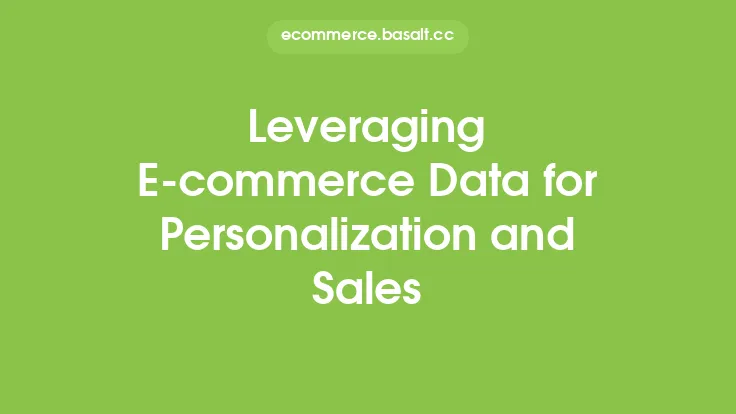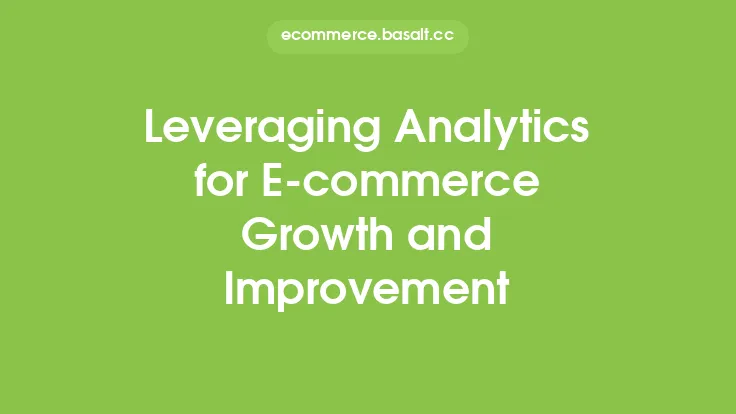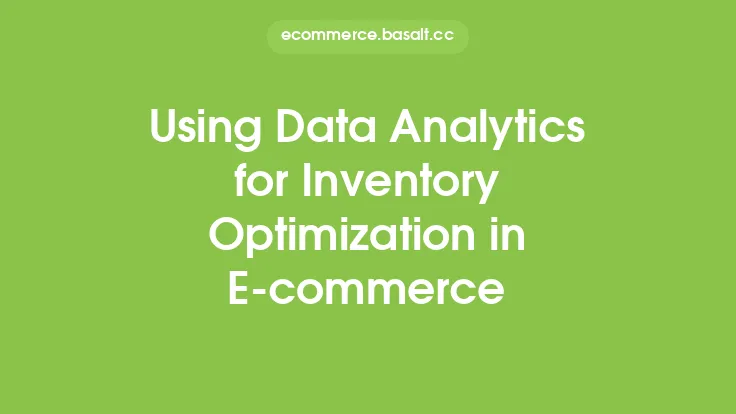In the world of e-commerce, personalization is key to driving sales, enhancing customer experience, and fostering loyalty. One of the most effective ways to achieve personalization is by leveraging e-commerce analytics. E-commerce analytics involves the collection, analysis, and interpretation of data related to online shopping behavior, customer interactions, and market trends. By harnessing the power of e-commerce analytics, businesses can gain valuable insights into their customers' preferences, behaviors, and needs, enabling them to create tailored experiences that meet their expectations.
Introduction to Personalization in E-commerce
Personalization in e-commerce refers to the practice of tailoring the online shopping experience to individual customers based on their unique characteristics, behaviors, and preferences. This can be achieved through various means, such as product recommendations, content customization, and targeted marketing campaigns. Personalization has become a crucial aspect of e-commerce, as customers increasingly expect online retailers to understand their needs and provide relevant experiences. By leveraging e-commerce analytics, businesses can unlock the full potential of personalization and reap its numerous benefits, including increased customer satisfaction, loyalty, and revenue.
The Role of Data in Personalization
Data is the backbone of personalization in e-commerce. By collecting and analyzing data on customer behavior, preferences, and demographics, businesses can create detailed profiles of their target audience. This data can be sourced from various channels, including website interactions, social media, customer feedback, and transactional data. Some common types of data used in personalization include:
- Demographic data: age, gender, location, income level
- Behavioral data: browsing history, search queries, purchase history
- Preference data: product ratings, reviews, wish lists
- Transactional data: order history, payment methods, shipping preferences
By analyzing this data, businesses can identify patterns, trends, and correlations that inform their personalization strategies.
E-commerce Analytics Tools for Personalization
A range of e-commerce analytics tools are available to help businesses collect, analyze, and interpret data for personalization. These tools can be broadly categorized into:
- Web analytics tools: Google Analytics, Adobe Analytics
- Customer data platforms: Salesforce, Adobe Customer Profile
- Marketing automation tools: Marketo, Pardot
- Personalization engines: Adobe Target, Salesforce Personalization
These tools provide businesses with the capabilities to collect and analyze data, create customer segments, and develop targeted marketing campaigns. By leveraging these tools, businesses can streamline their personalization efforts and achieve greater precision and effectiveness.
Strategies for Personalization
Several strategies can be employed to achieve personalization in e-commerce, including:
- Product recommendations: using data on customer behavior and preferences to suggest relevant products
- Content customization: tailoring website content, such as product descriptions and images, to individual customers
- Targeted marketing: using data on customer demographics and behavior to create targeted marketing campaigns
- Email personalization: using data on customer preferences and behavior to create personalized email campaigns
- Social media personalization: using data on customer social media behavior to create targeted social media campaigns
By implementing these strategies, businesses can create personalized experiences that resonate with their customers and drive business results.
Best Practices for Implementing Personalization
To ensure the effective implementation of personalization, businesses should follow several best practices, including:
- Collecting and analyzing high-quality data
- Creating detailed customer profiles
- Using machine learning algorithms to analyze data and make predictions
- Testing and refining personalization strategies
- Ensuring transparency and consent in data collection and usage
- Continuously monitoring and evaluating the effectiveness of personalization efforts
By following these best practices, businesses can unlock the full potential of personalization and achieve significant benefits, including increased customer satisfaction, loyalty, and revenue.
Overcoming Challenges in Personalization
While personalization offers numerous benefits, it also poses several challenges, including:
- Data quality and accuracy
- Customer privacy and consent
- Complexity and scalability
- Measuring and evaluating effectiveness
To overcome these challenges, businesses should prioritize data quality, ensure transparency and consent, and invest in scalable and flexible technologies. Additionally, businesses should continuously monitor and evaluate the effectiveness of their personalization efforts, making adjustments and refinements as needed.
Future of Personalization in E-commerce
The future of personalization in e-commerce is exciting and rapidly evolving. Emerging technologies, such as artificial intelligence, machine learning, and the Internet of Things, are expected to play a significant role in shaping the future of personalization. Additionally, the increasing use of mobile devices, social media, and voice assistants is expected to create new opportunities for personalization. As businesses continue to invest in personalization, we can expect to see even more innovative and effective strategies emerge, driving greater customer satisfaction, loyalty, and revenue in the world of e-commerce.





